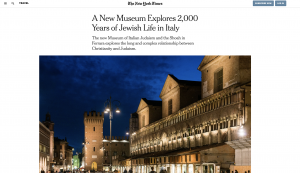CULTURE The Museum of Italian Judaism and the Shoah Featured in the New York Times
The Museum of Italian Judaism and the Shoah in Ferrara was featured in a long article in New York Times on Wednesday.
“The history of Jewish life in Italy might seem like one long saga of suffering and trauma: slavery by the Romans; the Inquisition and persecution by the Church; forced segregation to cramped neighborhoods in the Middle Ages. The first of many ghettos was established in Venice in 1516. The 20th century witnessed the rise of fascism, anti-Semitic racial laws and the Holocaust, when nearly 7,700 Jews out of a total population of 44,500 were killed. However, there is another part to the Italian Jewish story, one of acceptance, integration and even appreciation throughout the long arc of civilization on the peninsula,” wrote the author of the piece Harry D. Wall.
“As the museum moves chronologically through the eras of Italian history, additions are being made to the permanent exhibit. The second major exhibit opened in April, on Jews and the Renaissance,” he continued.
The piece also delves into the history of Jewish life in Ferrara, whose Jewish community peaked in the Middle Ages at around 2,000 people.
Later, “after the reign of the House of Este ended, the church became ascendant, anti-Semitic persecution intensified and Jews were confined to living in a ghetto from around 1627 until the emancipation in 1859,” it is explained.
The main streets of the ancient Ghettos are currently in the heart of the buzzling city center.
“The MEIS tells the story of a minority, which was integrated in the Italian society and, at the same time, was able to maintain its identity, both cultural and religious, without being assimilated,” Dario Disegni, chairman of MEIS, told the New York Times. “It is really a model, a point of reference for the Italian and, more generally, Western societies of today.”

